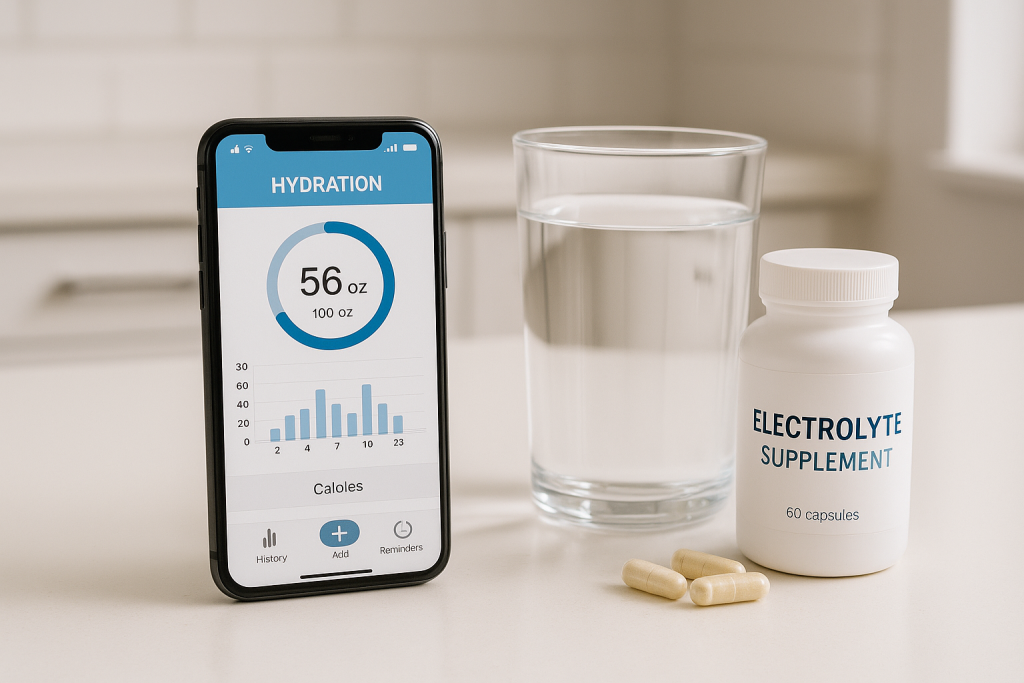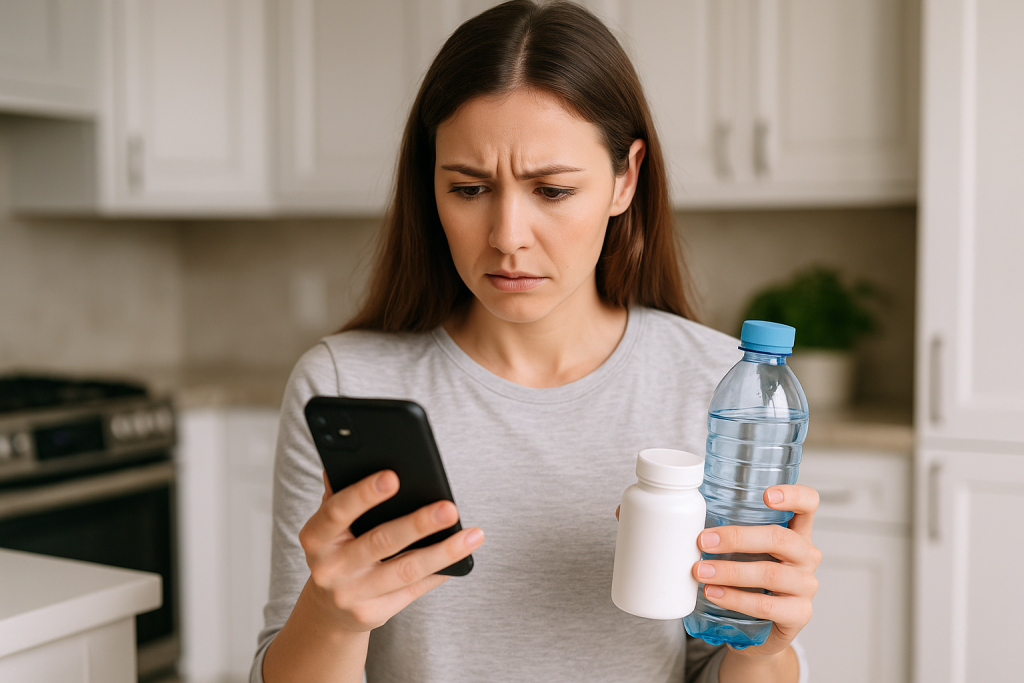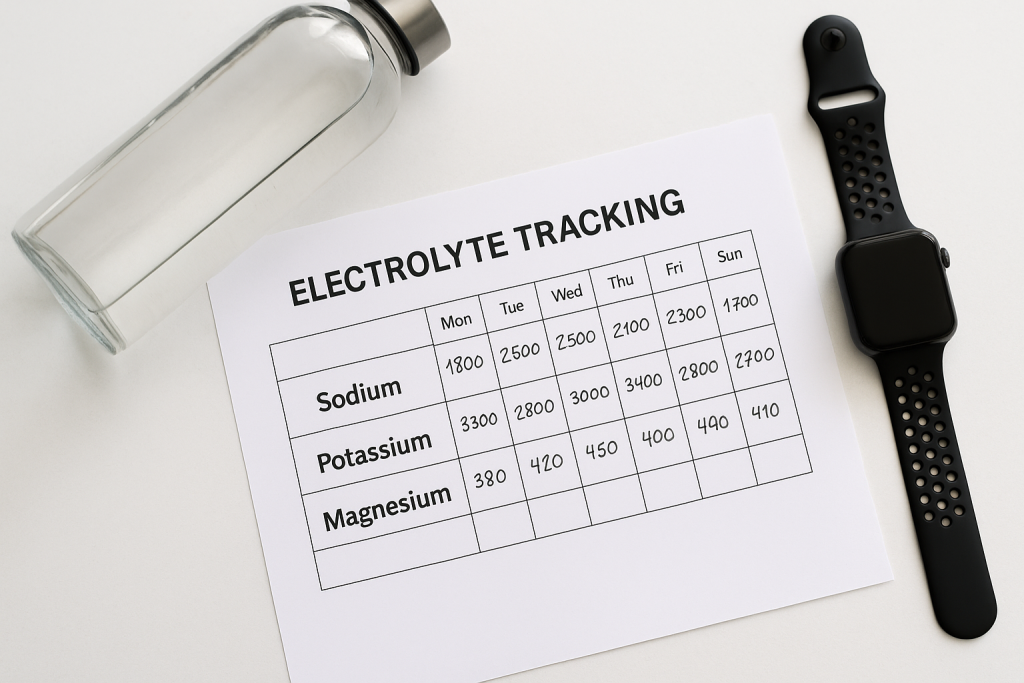If you’re using a water intake tracker but also take electrolyte supplements, you risk missing critical interaction warnings. While staying hydrated is essential, combining hydration apps with supplement use can create hidden conflicts if not monitored correctly.
This article explores the current state of hydration tracking apps, their limitations around electrolyte management, and what to look for if you’re managing fluid intake alongside sodium, potassium, or magnesium supplementation.
Let’s examine how to get smarter about fluid balance – and avoid common pitfalls.
Summary / Quick Answer
Many hydration apps track water intake, but few include electrolyte warnings or supplement conflict alerts. Here’s what you need to know:
- Most hydration apps (e.g., Waterllama, WaterMinder) track only water – no supplement alerts
- Some nutrition apps (e.g., Cronometer) log electrolytes via food, but miss supplement warnings
- No single app fully handles hydration + supplement conflict alerts
- Too much sodium or potassium can cause heart, kidney, or blood pressure issues
- Manual tracking or combining multiple apps is currently the safest approach
For users combining supplements and hydration efforts, being proactive is essential. Look for apps that include full nutrient databases, or check out our guide to the best app for tracking vitamin and drug interactions.
Why Hydration Tracking Isn’t Enough

Water tracking apps are growing in popularity, but they often ignore a key factor: electrolytes. Sodium, potassium, calcium, and magnesium are crucial for hydration balance, especially if you’re active, on a keto diet, or take supplements.
Most apps like WaterMinder and Waterllama help you meet daily fluid goals by setting reminders based on your body size, activity, and climate. But they stop short of addressing mineral intake. Electrolyte levels affect how well your body uses the water you drink, and without balance, more water can actually dilute essential minerals.
Why it matters:
- Overhydration can lead to hyponatremia, or dangerously low sodium
- Some supplements (e.g., magnesium or potassium) interact with medications like ACE inhibitors or diuretics
- Users on keto diets often increase sodium intake, risking imbalance
👉 If you’re taking potassium supplements with an ACE inhibitor, read this warning: Potassium supplements and ACE inhibitor dangers.
Think of hydration as a three-part equation: fluids + electrolytes + medications. Apps that only focus on the first part leave you guessing about the rest.
Visual: Basic Hydration vs Full Intake Monitoring
| Tracking Focus | Most Hydration Apps | Ideal System |
|---|---|---|
| Water intake | ✅ | ✅ |
| Electrolytes (food) | ❌ | ✅ |
| Electrolytes (supp.) | ❌ | ✅ |
| Drug-nutrient alerts | ❌ | ✅ |
| AI + personalization | Some | ✅ |
Apps with Electrolyte or Supplement Features

A few apps go beyond water tracking. Here’s how they compare:
1. SuppTrack
Designed for supplement users, SuppTrack includes over 185,000 products and flags excessive ingredient intake. However, it lacks hydration monitoring. It’s best paired with a water-focused app.
2. Cronometer
Widely used for detailed nutrient tracking, Cronometer logs sodium, potassium, calcium, and magnesium from food. It’s ideal for spotting electrolyte trends – but not all supplements are included by default.
3. Connected Hydration
Epicore Biosystems’ Connected Hydration uses wearable tech to detect sweat and real-time electrolyte loss. It’s great for athletes but limited to users with specific gear. Interaction warnings are not included.
4. MyFitnessPal
Offers partial electrolyte logging but relies heavily on user-generated data. That means inconsistent accuracy – especially for potassium and magnesium.
5. AI Water App
An AI-powered hydration assistant using GPT-4 technology. While it creates personalized water goals, it currently lacks detailed electrolyte or drug-supplement conflict tracking.
Want a solution that tracks both hydration and drug interactions? Try our best app for tracking vitamin and drug interactions.
Visual: App Capabilities Comparison
| App Name | Water Tracking | Electrolytes | Supplements | Conflict Warnings |
| Waterllama | ✅ | ❌ | ❌ | ❌ |
| SuppTrack | ❌ | ❌ | ✅ | ⚠️ Partial |
| Cronometer | ✅ (indirect) | ✅ | ⚠️ Partial | ❌ |
| Connected Hydration | ✅ (wearable) | ✅ | ❌ | ❌ |
| AI Water App | ✅ | ❌ | ❌ | ❌ |
The Risks of Ignoring Electrolyte Warnings
Most people focus on hydration without realizing that electrolyte excess can be as dangerous as dehydration. This is especially true when combining supplements with medications.

Too much sodium or potassium may cause:
- Dizziness or confusion
- Muscle cramps or weakness
- Irregular heartbeat or chest pain
- Water retention and swelling
- Kidney damage or elevated blood pressure
Even high magnesium levels can cause diarrhea, especially when mixed with drugs like metformin. See: Diarrhea from magnesium and metformin combination.
How much is too much?
| Electrolyte | Common Upper Limit | Risks if Exceeded |
| Sodium | 2,300 mg/day | BP rise, bloating |
| Potassium | 3,000-4,700 mg/day | Heart risks |
| Magnesium | 350 mg/day (supp.) | Diarrhea, fatigue |
👉 On keto or sweating heavily? You might need more – but check with a healthcare provider.
Why Medical Input Still Matters
Most hydration and supplement apps are not FDA-regulated. According to research, only 6.3% of health apps involve physicians in their development. Worse, only 19% remind users to consult a doctor.
Without medical oversight, the risk of mismanaging fluid and electrolyte intake increases – especially in those on diuretics, ACE inhibitors, or steroid medications. One overlooked example is joint pain from calcium supplements and steroids.
Apps should guide – not replace – professional advice. Use them as tools, not prescriptions.
Conclusion
There’s currently no perfect hydration app that covers water intake, electrolyte tracking, and supplement conflict warnings all in one place. However, by combining tools like Waterllama, Cronometer, and SuppTrack – and staying aware of potential interactions – users can build a safer system.
For anyone using medications or mineral supplements, the best approach is still personalized: stay informed, use smart trackers, and talk to your provider about changes in diet or supplementation.
You may also want to explore:

